The Pleco iPhone App (beta)
I just recently had the pleasure of trying out the beta version of the new Pleco iPhone app. In case you’re not aware, Pleco is the software company behind what is regarded as the best electronic learner’s Chinese dictionary for any mobile device (and possibly the desktop as well). Given the dearth of really good Chinese dictionaries for the iPhone, Chinese learners have been eagerly awaiting the release of this iPhone app for quite some time. The wait has not been in vain; Pleco for iPhone is an outstanding app.
The Video Demo
Michael Love, Pleco founder, has made a two-part video of the new Pleco iPhone app:
For those of you in China, visit Pleco’s mirror site for the videos.
An All-New UI
I’ve never owned a device running Windows Mobile or Palm OS, so I’ve never been able to own Pleco before, but I’m familiar enough with previous versions to make basic comparisons.
The Pleco user interface received a much-needed makeover for the iPhone. While older versions of Pleco squeezed a plethora of buttons and options onto the screen (you have your stylus, after all), this iPhone Pleco had to find ways to increase buttons to tappable sizes and limit button clutter by hiding options on screens where you don’t need them all. Compare (Windows Mobile on the left, iPhone on the right):
I chose the iPhone app’s landscape mode for comparison because that way it contains more of the same features as the Windows Mobile version. When held upright, the screen is even less cluttered.
Most screens in the iPhone app save space by hiding the “top-level” menu. You can display it (revealing the “Dict,” “Reader,” “Settings,” and “Add-ons” choices) by clicking on the fan-like icon at the lower right:
Dictionary Choices
When you first install the app, you can download the dictionaries you have purchased through Pleco. Choices include:
> Cheng & Tsui E-C Business Lexicon (0.7 MB)
> Tuttle Learner’s Chinese-English Dict (1.2 MB)
> Stroke Order Diagrams (2.7 MB)
> ABC English-Chinese Dictionary (2.9 MB)
> NWP English-Chinese Dictionary (4.3 MB)
> Xiandai Hanyu Guifan Cidian (11.5 MB)
> ABC Chinese-English Dictionary (21.3 MB)
> 21st Century English-Chinese Dict (47.9 MB)
> Audio Pronunciation (female) (197.9 MB)
> Audio Pronunciation (male) (197.9 MB)
Screenshots for dictionary add-ons and management:
Switching between dictionaries is an easy button press from any dictionary page (note the letters in the lower left corner):
The iPhone app even has popup definitions for words in definitions, and even lets you switch dictionaries for those popups (note the letters in the black bar on the popup). Check out these screenshots:
(No popups in popups, though!)
Handwriting Input
This is a big one. Pleco for iPhone has very impressive handwriting recognition. You really need to watch the video to see how it works, but the two-finger swipe is genius. Pleco has definitely improved upon Apple’s handwriting input, and it’s at least as good as nciku’s, as well. It has two orientations:
Here are some more screenshots:
And having some fun with it:
Some Nice Touches
Pleco for iPhone also lets you zoom in on characters and get the animated stroke order for any character:
And you probably noticed that Pleco for iPhone, like its predecessors, supports color-coded tones. Its default setting is not Dummitt’s scheme; it’s Pleco’s own scheme, more similar to the tone/color scheme I proposed. But the colors, like most everything in the app, are configurable:
One major feature I won’t go into here is the Reader. It basically enables Pleco to do everything that desktop apps like Wenlin and Clavis Sinica can do, all in a tiny iPhone app (and with a better interface). Extremely handy for Chinese study on the go.
No flashcards yet, but off to a good start
The Pleco iPhone app is still in beta, so some of this stuff could change. It also doesn’t have flashcards yet, but Michael tells us in the video that it’s coming soon.
Also, you should have absolutely no concerns about the speed of the app. I tested it on an iPhone 2G (the original iPhone) running the 3.0 iPhone firmware, and had no problems. No lag, no freezes, no crashes. When Michael Love says in the video that “it screams” on the iPhone hardware, he’s not kidding. I imagine this is especially true on the new iPhone 3GS, but it ran fine on my 2G as well.
I also have an interview with Michael Love in which he talks about the technical and design challenges the iPhone presented, the delay, the price, the anticipated public release, and Android possibilities. That will be coming out next!
Finally, if you’d like to see more screenshots, there are more in the Pleco iPhone app (beta) photo set I put up on Flickr.
Related: Interview with Pleco founder Michael Love on developing the Pleco iPhone App, Using ChinesePod Vocabulary with Pleco

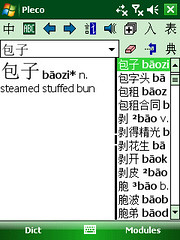
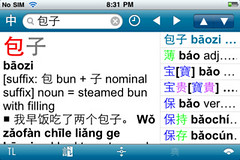

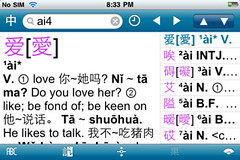
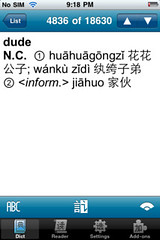

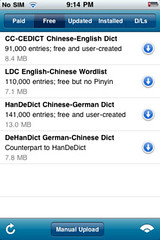
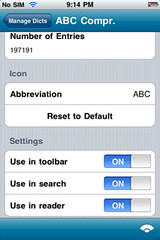

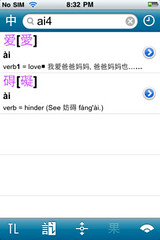


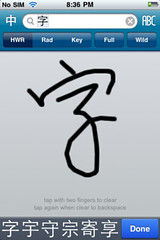
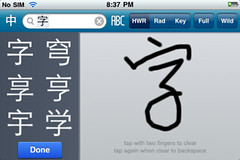
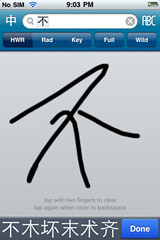
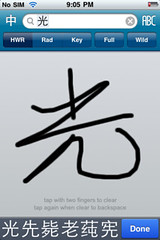
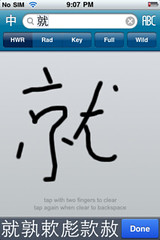
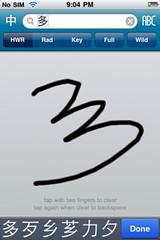
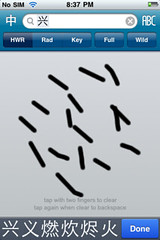
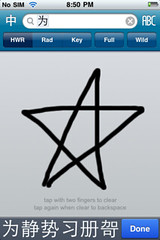




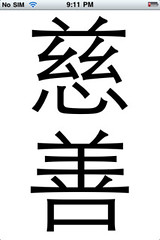

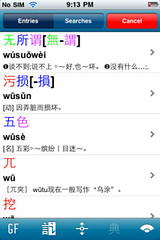
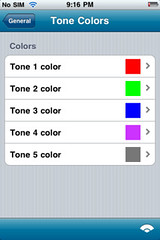
I’m looking forward to this.
this looks great. when is the date for public release?
Fantastic post John, thanks!
Looks awesome and makes me wish I had an iPhone. My Windows Mobile version will just have to do.
Looks fantastic! What is your preferred dictionary? Why? I’m inclined to use the ABC dictionary because I use Wenlin a lot, but it doesn’t seem to be the most thorough. I look forward to the interview.
I bought a Palm Treo specifically just for Plecodict — and I haven’t upgraded my phone largely because of that.
Did they say anything about an android version?
Thanks for the great post —
Having just switched to the iPhone, I’m very interested in this. My main concern, though, is the price. There are several CC-CEDICT-based dictionaries available for free on the iPhone. So far they have proven “good enough” for my uses. Given that many high-quality hardcover dictionaries (for other languages; I’m thinking specifically of Eijirō EJ/JE and Daijirin JJ) are already available for $10-$20, I will certainly not be willing to fork over $60, much less $200.
I’m really looking forward to this, especially now that it seems custom dictionaries may be an option after all. The handwriting recognition looks great — far better than the native iPhone handwriting input — and the multitouch features are the sexiest sex-o. Deeply, deeply looking forward to ditching the CEDICT-based apps I’ve been stuck with on the iPhone so far.
@Kevin — the last I heard, an Android version wasn’t planned, but who knows if that’ll change.
Should not support apple and there restrictive ways. PLEASE make a similar version for Android. To John…are you still using the HTC phone you previously wrote about, or are you back to the evil iphone.
Thanks for the review! I’ve been waiting for this for so long. The wait has clearly not been in vain.
Wow, looks very nice. I want!
You might be interested to know that the Palm version costs between $60 and $200 depending on how many dictionaries you have, so we’d expect the iPhone version to be similar.
[…] following is an interview with Pleco founder Michael Love, regarding the Pleco iPhone app, which is now in beta […]
I can’t wait to try this out……Looks like a great tool. I wonder how it will compare to some of the other great offerings for the iphone
[…] review of the beta iPhone app is also available, with links to video demonstrations by […]
I just want a comprehensive Chinese dictionary for my iPhone. Chinese-Chinese is fine, Chinese-English is good too. Currently I mostly use two web-based dictionaries: 教育部重編國語辭典修訂本 and 林語堂《當代漢英詞典》電子版. I get the impression that Pleco is trying to do a lot — almost to rewrite the iPhone OS — but it is not trying to give me a really good dictionary, and nothing more than a dictionary.
[…] A neat review of the Pleco iPhone App on Sinosplice. This is a big one. Pleco for iPhone has very impressive handwriting recognition. You really need to watch the video to see how it works, but the two-finger swipe is genius. Pleco has definitely improved upon Apple’s handwriting input, and it’s at least as good as nciku’s, as well. […]
[…] reviewing the beta version, interviewing Michael Love on the app, and commenting on beta testing progress, I’d be remiss […]
The extra dictionary add-ons I think are necessary. Often I have met a phrase / word which was not in the Pleco dictionary, especially words of more than a single character.
The Full screen handwriting feature is necessary – have to pay more for it than the standard half screen, because the latter is just not accurate enough – very frustrating too if you get the stroke order wrong or your strokes are slightly out of orientation – and the correct character just does not appear among the options.
Actually I bought the iPOd especially because it has this feature, after seeing my classmates using one!
I have also noticed, conversions of OCR are not correct and converted document has to be manually edited. I think Free OCR services are therefore not complete in themselves have to be complemented by manual inputs.